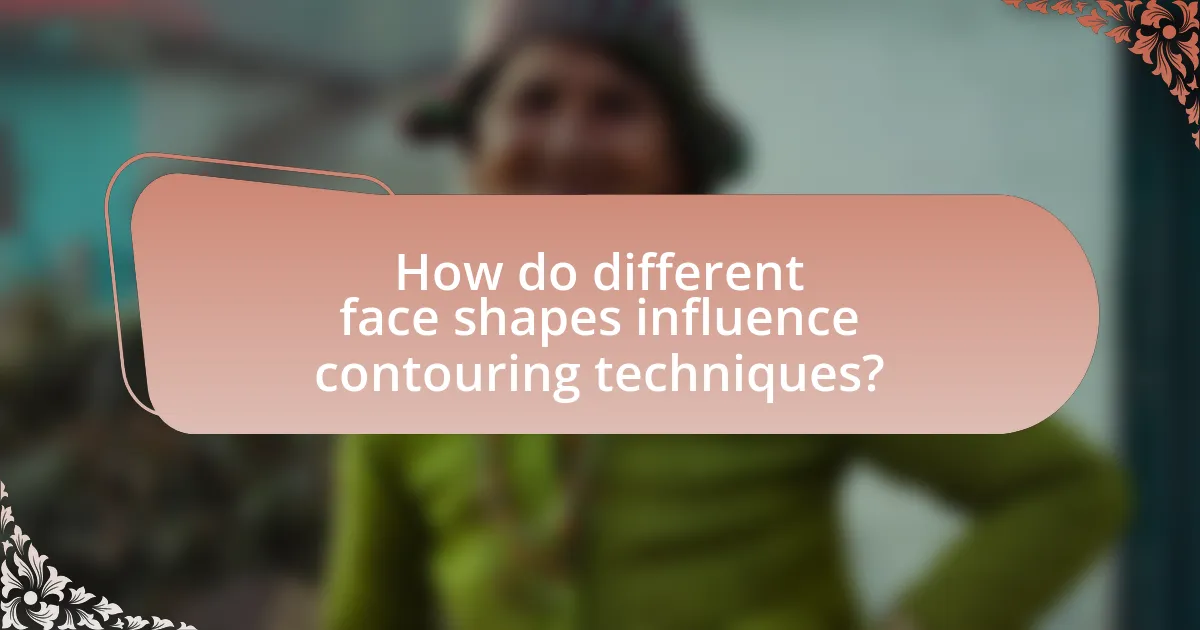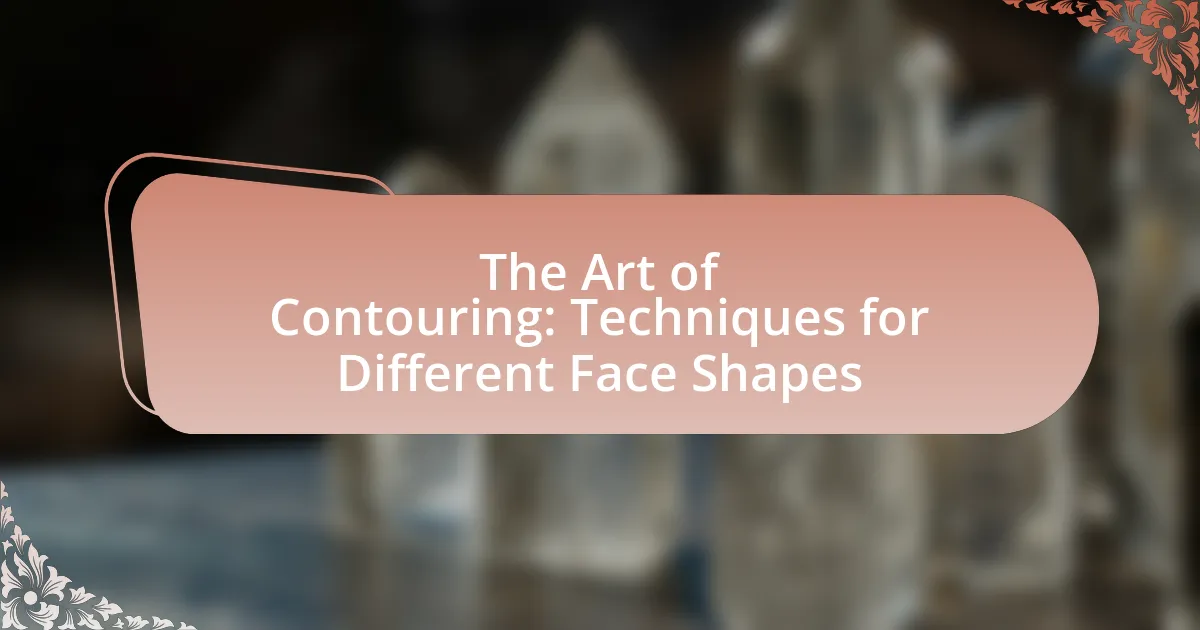The article focuses on the art of contouring, a makeup technique that enhances facial structure through the strategic application of lighter and darker shades. It explores the historical influences that shaped contouring, its rise in popularity due to social media and celebrity endorsements, and the basic principles involved in effective contouring. Additionally, the article discusses how different face shapes—such as oval, round, square, heart, and diamond—affect contouring techniques, providing tailored strategies for each shape. Essential products, common mistakes, and advanced techniques for achieving various looks are also covered, making it a comprehensive guide for both beginners and experienced makeup enthusiasts.

What is the Art of Contouring?
The art of contouring is a makeup technique used to define and enhance the natural structure of the face by using lighter and darker shades of makeup. This technique involves applying darker shades to areas of the face that one wishes to recede, such as the sides of the nose and under the cheekbones, while lighter shades are applied to areas that should be highlighted, like the forehead and cheekbones. Contouring has been popularized by beauty influencers and is supported by the fact that it can create the illusion of more sculpted features, as evidenced by its widespread use in professional makeup artistry and tutorials.
How did contouring become a popular makeup technique?
Contouring became a popular makeup technique primarily due to its promotion by celebrities and social media influencers, particularly in the 2010s. The technique gained widespread attention after Kim Kardashian shared her contouring routine on social media, showcasing how it could enhance facial features. This visibility led to a surge in demand for contouring products and tutorials, as consumers sought to replicate the looks seen on platforms like Instagram and YouTube. The rise of beauty influencers and makeup artists further solidified contouring’s status, with many creating content that demonstrated various techniques tailored to different face shapes, thus making it accessible to a broader audience.
What historical influences shaped the art of contouring?
The art of contouring has been shaped by various historical influences, primarily from theatrical makeup practices and the beauty standards of different cultures. Theatrical makeup in the 19th century emphasized the use of shadows and highlights to create depth on stage, which laid the groundwork for modern contouring techniques. Additionally, ancient Egyptian beauty rituals involved the use of kohl and other substances to define facial features, influencing contemporary practices. The rise of Hollywood in the early 20th century further popularized contouring, as stars like Marilyn Monroe used makeup to enhance their features, setting trends that continue to impact beauty standards today.
How has social media impacted the popularity of contouring?
Social media has significantly increased the popularity of contouring by providing a platform for influencers and makeup artists to showcase techniques and tutorials. Platforms like Instagram and TikTok allow users to share before-and-after photos and videos, demonstrating the transformative effects of contouring. According to a 2021 survey by Statista, 54% of respondents reported that social media influenced their makeup choices, highlighting the role of online content in shaping beauty trends. This visibility has led to a surge in demand for contouring products and techniques, making it a staple in modern makeup routines.
What are the basic principles of contouring?
The basic principles of contouring involve using makeup to enhance or alter the natural structure of the face by creating shadows and highlights. Contouring typically requires a matte product that is a few shades darker than the skin tone to create shadows, applied to areas such as the sides of the nose, under the cheekbones, and along the jawline. Highlighting, using a lighter, shimmery product, is applied to areas that naturally catch light, such as the tops of the cheekbones, the bridge of the nose, and the brow bone. This technique relies on the principles of light and shadow to define and sculpt the face, creating the illusion of depth and dimension.
What products are essential for effective contouring?
The essential products for effective contouring include contour cream or powder, highlighter, and blending tools such as brushes or sponges. Contour cream or powder is used to create shadows on the face, defining features like the cheekbones and jawline. Highlighter is applied to areas where light naturally hits the face, such as the cheekbones and brow bones, to enhance the overall structure. Blending tools are crucial for seamlessly merging the contour and highlight products into the skin for a natural finish. These products are widely recognized in the beauty industry for their effectiveness in achieving a sculpted look.
How do light and shadow play a role in contouring?
Light and shadow are essential in contouring as they define the structure and shape of the face. By strategically applying lighter shades to areas where light naturally hits, such as the forehead, cheekbones, and chin, and darker shades to areas that recede, like the sides of the nose and jawline, one can create the illusion of depth and dimension. This technique is supported by the principles of light and shadow in art and makeup, where the contrast between highlights and lowlights enhances facial features, making them appear more sculpted.

How do different face shapes influence contouring techniques?
Different face shapes significantly influence contouring techniques by determining where to apply light and shadow for optimal enhancement. For example, individuals with oval faces benefit from subtle contouring along the jawline and temples to maintain their natural shape, while those with round faces should contour the sides of the face to create the illusion of length. Square faces often require contouring on the jawline and forehead to soften angular features, whereas heart-shaped faces can use contouring on the forehead and under the cheekbones to balance the wider upper face. These techniques are supported by the principles of makeup artistry, which emphasize the importance of enhancing natural features through strategic application of products.
What are the main face shapes to consider in contouring?
The main face shapes to consider in contouring are oval, round, square, heart, and diamond. Each shape has distinct characteristics that influence contouring techniques. For instance, an oval face is considered ideal for contouring as it is well-balanced, while a round face may benefit from contouring to elongate its appearance. A square face often requires contouring to soften the jawline, whereas a heart-shaped face may need emphasis on the forehead and chin. Lastly, a diamond face shape can be enhanced by contouring the forehead and jawline to create balance. These techniques are widely recognized in beauty and makeup literature, confirming their relevance in effective contouring practices.
How can you identify your face shape for contouring?
To identify your face shape for contouring, measure the width of your forehead, cheekbones, and jawline, and assess the length of your face. The specific measurements will help categorize your face into one of the common shapes: oval, round, square, heart, or diamond. For example, an oval face has a forehead slightly wider than the jawline, while a round face has equal width and length with full cheeks. Accurate identification allows for tailored contouring techniques that enhance your natural features, as different shapes require distinct contouring strategies to achieve balance and definition.
What are the characteristics of each face shape?
The characteristics of each face shape include the following:
-
Oval: An oval face shape features balanced proportions, with the forehead slightly wider than the chin and high cheekbones. This shape is considered versatile for various hairstyles and makeup techniques.
-
Round: A round face shape has equal width and length, with full cheeks and a rounded chin. The goal in contouring is often to elongate the appearance of the face.
-
Square: A square face shape is characterized by a strong jawline, a broad forehead, and equal width across the forehead, cheekbones, and jaw. Contouring typically softens the angles of the face.
-
Heart: A heart-shaped face has a wider forehead and cheekbones, tapering down to a narrow chin. Contouring can help balance the proportions by adding width to the chin area.
-
Long: A long face shape is longer than it is wide, with a narrow forehead and chin. Contouring aims to create the illusion of width, particularly at the cheeks.
-
Diamond: A diamond face shape features a narrow forehead and chin with wide cheekbones. Contouring can soften the angles and add balance to the overall appearance.
These characteristics are widely recognized in beauty and makeup literature, providing a foundation for contouring techniques tailored to each face shape.
How should contouring techniques vary by face shape?
Contouring techniques should vary by face shape to enhance natural features effectively. For oval faces, contouring is minimal, focusing on highlighting the forehead and chin to maintain balance. Round faces benefit from contouring along the sides of the face to create the illusion of length, while square faces require contouring on the jawline and temples to soften angles. Heart-shaped faces should contour the forehead and chin to create harmony, while long faces need contouring on the sides of the forehead and chin to shorten the appearance. These techniques are supported by makeup artistry principles that emphasize the importance of face shape in achieving a flattering look.
What contouring techniques work best for oval faces?
The best contouring techniques for oval faces include applying contour along the sides of the forehead, under the cheekbones, and along the jawline. This technique enhances the natural balance of an oval face by subtly defining features without altering the overall shape. Specifically, using a matte bronzer or contour product, one should focus on the temples and the sides of the forehead to create dimension, while highlighting the center of the forehead, the tops of the cheekbones, and the chin to maintain the face’s natural symmetry. This approach is supported by makeup artists who emphasize that oval faces benefit from contouring that enhances their naturally harmonious proportions.
How can square faces benefit from specific contouring methods?
Square faces can benefit from specific contouring methods by softening the angular features and creating a more oval appearance. Contouring techniques such as applying darker shades along the jawline and temples can reduce the prominence of the squared jaw, while highlighting the center of the forehead and chin can add dimension and balance. Research indicates that contouring can enhance facial symmetry, which is particularly beneficial for square face shapes that may appear more rigid. By strategically using contouring products, individuals with square faces can achieve a more harmonious and flattering look.
What contouring strategies are effective for round faces?
Effective contouring strategies for round faces include applying contour products along the sides of the forehead, under the cheekbones, and along the jawline. This technique helps create the illusion of a more elongated face shape. Specifically, using a matte bronzer or contour powder that is two shades darker than the skin tone can enhance these areas, while highlighting the center of the forehead, the tops of the cheekbones, and the chin can add dimension. Research indicates that strategic shading can significantly alter perceived facial structure, making these methods widely recommended by makeup artists for round face shapes.
How can heart-shaped faces achieve balance through contouring?
Heart-shaped faces can achieve balance through contouring by applying darker shades to the forehead and temples while highlighting the chin and jawline. This technique reduces the width of the forehead and enhances the lower part of the face, creating a more harmonious appearance. Specifically, contouring the temples and sides of the forehead narrows the upper face, while highlighting the chin adds dimension and draws attention downward, balancing the overall proportions. This method is supported by makeup artistry principles that emphasize the importance of creating symmetry and proportion in facial features.

What are advanced contouring techniques for specific looks?
Advanced contouring techniques for specific looks include the use of cream and powder products to sculpt the face, highlighting specific areas to enhance features, and employing techniques like strobing for a luminous finish. For example, to achieve a chiseled jawline, one can apply a darker contour shade along the jaw and blend it well, while using a highlighter on the chin and the center of the jaw to create contrast. Additionally, for a more dramatic look, techniques such as reverse contouring, where highlighter is applied before foundation, can create a soft, diffused effect. These methods are supported by professional makeup artists who emphasize the importance of blending and color matching to achieve a natural appearance.
How can contouring enhance features for special occasions?
Contouring can enhance features for special occasions by creating shadows and highlights that define and sculpt the face, resulting in a more polished and photogenic appearance. This technique allows for the accentuation of cheekbones, the narrowing of the nose, and the elongation of the jawline, which are particularly beneficial for events where photography is prevalent. Studies have shown that makeup techniques like contouring can significantly improve perceived attractiveness and facial symmetry, making it a popular choice for occasions such as weddings, parties, and professional photoshoots.
What techniques are recommended for a natural daytime look?
For a natural daytime look, techniques include using lightweight foundation or tinted moisturizer, applying cream blush for a dewy finish, and utilizing neutral eyeshadow shades. These methods enhance features without appearing heavy. Lightweight foundation or tinted moisturizer provides a sheer coverage that evens skin tone while allowing natural texture to show through. Cream blush adds a fresh, natural flush to the cheeks, blending seamlessly into the skin. Neutral eyeshadow shades, such as soft browns or taupes, create subtle definition on the eyelids, enhancing the eyes without overwhelming them. These techniques are widely recommended by makeup artists for achieving a fresh, effortless appearance suitable for daytime wear.
How can contouring be adapted for dramatic evening makeup?
Contouring for dramatic evening makeup can be adapted by using deeper shades and more pronounced techniques to enhance facial features under artificial lighting. This involves applying a darker contour product along the jawline, cheekbones, and forehead to create a more sculpted appearance, while highlighting the high points of the face with a lighter shade to add dimension. The use of cream or liquid products is often preferred for evening looks, as they blend seamlessly and provide a more intense finish. Additionally, setting the contour with a translucent powder can ensure longevity and prevent fading throughout the night.
What common mistakes should be avoided in contouring?
Common mistakes to avoid in contouring include using the wrong shade, applying too much product, and neglecting to blend properly. Using a contour shade that is too dark can create harsh lines, while applying excessive product can lead to an unnatural appearance. Additionally, failing to blend the contour seamlessly into the skin can result in noticeable streaks. These mistakes can detract from the intended effect of enhancing facial features and achieving a natural look.
How can over-contouring affect the final look?
Over-contouring can lead to an unnatural and harsh appearance on the face. When excessive product is applied, it can create stark lines and shadows that do not blend seamlessly with the skin, resulting in a mask-like effect. This is particularly evident in bright lighting, where the contrast between the contoured areas and the rest of the face becomes more pronounced. Studies in makeup artistry emphasize that proper blending and moderation are key to achieving a natural look, as over-contouring can detract from the intended enhancement of facial features.
What are the signs of poorly blended contouring?
Signs of poorly blended contouring include harsh lines, uneven application, and a lack of seamless transition between shades. Harsh lines occur when the contour and highlight products are not blended adequately, creating stark contrasts that are visually unappealing. Uneven application can result in certain areas appearing overly dark or light, disrupting the natural look intended by contouring. Additionally, a lack of seamless transition indicates that the contouring does not flow naturally with the skin tone, making the makeup appear artificial. These signs are critical for identifying ineffective contouring techniques.
What are some practical tips for mastering contouring?
To master contouring, start by selecting the right products, such as cream or powder formulas that match your skin type and tone. Using a contour shade two shades darker than your skin tone, apply it to areas like the hollows of your cheeks, jawline, and sides of your nose to create depth. Highlighting with a shade two shades lighter on the high points of your face, such as the cheekbones, brow bones, and the bridge of your nose, enhances the contour effect. Blending is crucial; use a damp beauty sponge or brush to seamlessly blend the products for a natural look. Practicing on different face shapes helps in understanding how to adapt techniques effectively, as different shapes require tailored approaches for optimal results.
How can beginners practice contouring effectively?
Beginners can practice contouring effectively by starting with a basic understanding of their face shape and using the right products. Identifying whether one has a round, oval, square, or heart-shaped face allows for targeted contouring techniques that enhance natural features. For instance, using a matte bronzer or contour cream to create shadows along the jawline, under the cheekbones, and on the sides of the nose can define the face.
Additionally, beginners should use blending tools like makeup sponges or brushes to ensure a seamless application, as harsh lines can detract from the desired effect. Practicing in natural light helps to see how the makeup appears in different lighting conditions, ensuring a more realistic finish. According to a study published in the Journal of Cosmetic Dermatology, proper blending techniques significantly improve the overall appearance of makeup, making it essential for beginners to focus on this aspect.
What tools and brushes are best for contouring?
The best tools and brushes for contouring include an angled contour brush, a flat foundation brush, and a beauty sponge. An angled contour brush allows for precise application along the cheekbones and jawline, while a flat foundation brush is effective for blending cream or liquid contour products seamlessly. A beauty sponge is ideal for achieving a soft, airbrushed finish, particularly when working with cream contours. These tools are widely recommended by makeup artists for their effectiveness in creating defined and sculpted facial features.


